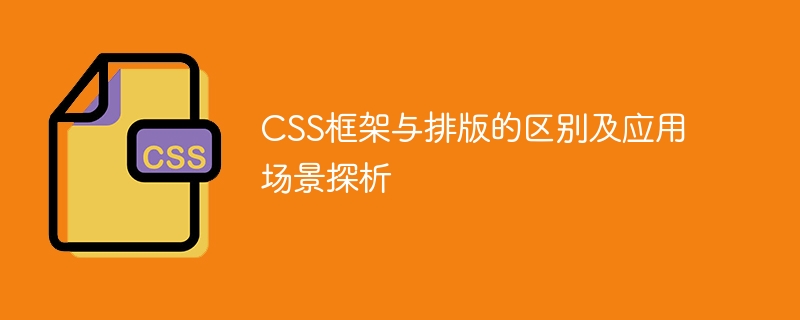Home >Web Front-end >CSS Tutorial >Analyze the similarities, differences and application scenarios of CSS framework and typesetting
Analyze the similarities, differences and application scenarios of CSS framework and typesetting
- 王林Original
- 2024-01-16 08:04:051267browse

The difference between CSS framework and typesetting and analysis of application scenarios
CSS framework and typesetting are two concepts often used in front-end development. Although they all involve the processing of web page layout and style, in specific practice, they have different functions and application scenarios. This article will explore the differences between CSS frameworks and typography, and provide some concrete code examples.
1. The concept and application scenarios of CSS framework
CSS framework is a front-end development tool written based on CSS. It provides a series of styles and layout templates to simplify web development. process. Common CSS frameworks include Bootstrap, Foundation, etc. They all provide a rich set of style libraries and components to meet the needs of different projects.
The main function of the CSS framework is to provide a set of standard styles and layout templates so that developers can build web pages more quickly. By using the CSS framework, developers do not need to write style code from scratch. They only need to introduce the corresponding CSS files and use them according to the style classes provided by the framework to quickly build a consistent and reusable interface.
In actual development, the CSS framework is suitable for projects that require rapid prototyping and time constraints. It can be used to build responsive web pages and mobile applications, and can handle the adaptation problem of different screen sizes. In addition, the CSS framework also provides some commonly used UI components and styles, such as buttons, forms, navigation menus, etc., which can greatly improve development efficiency.
The following is a sample code that uses the Bootstrap framework to build a simple web page:
<!DOCTYPE html>
<html lang="en">
<head>
<meta charset="UTF-8">
<meta name="viewport" content="width=device-width, initial-scale=1.0">
<link rel="stylesheet" href="https://cdn.jsdelivr.net/npm/bootstrap@5.0.0-alpha1/dist/css/bootstrap.min.css">
<title>Bootstrap Example</title>
</head>
<body>
<div class="container">
<h1>Welcome to Bootstrap</h1>
<p>This is a simple example of using Bootstrap framework.</p>
<button class="btn btn-primary">Click me</button>
</div>
</body>
</html>2. The concept and application scenarios of typesetting
Typesetting refers to the text content in the web page. Adjust the font, font size, line spacing, paragraph spacing and other styles to make the text content present a good reading effect and visual hierarchy. The goal of typography is to improve user experience and readability.
In actual development, typesetting is a meticulous task. By adjusting the text style, such as font size, line spacing, etc., you can make the text on the web page easier to read and also increase the beauty of the page. Typesetting technology can be applied to various types of web pages, such as news information, blog posts, e-books, etc.
The following is a sample code using CSS typography style:
<!DOCTYPE html>
<html lang="en">
<head>
<meta charset="UTF-8">
<meta name="viewport" content="width=device-width, initial-scale=1.0">
<title>Typography Example</title>
<style>
body {
font-family: Arial, sans-serif;
font-size: 16px;
line-height: 1.6;
color: #333333;
}
h1 {
font-size: 24px;
font-weight: bold;
margin-bottom: 20px;
}
p {
margin-bottom: 10px;
}
a {
color: #0066cc;
text-decoration: none;
}
</style>
</head>
<body>
<h1>Welcome to Typography Example</h1>
<p>This is an example of using CSS to create well-designed typography.</p>
<p>Lorem ipsum dolor sit amet, consectetur adipiscing elit. Sed et condimentum est, ac vehicula nisl. <a href="#">Read more</a></p>
</body>
</html>3. The difference and connection between CSS framework and typography
CSS framework and typography both involve the layout of the web page and style processing, but their functions and application scenarios are different. The CSS framework is suitable for quickly building web page prototypes and providing a consistent and reusable interface, while typography focuses more on the display and reading experience of text content.
In practice, CSS framework and typesetting can be used in combination. Developers can use the CSS framework to build the basic layout and style of web pages, and then adjust the style of text content through typesetting technology to make the web page more beautiful and readable.
To sum up, CSS framework and typesetting have different roles and application scenarios in front-end development. Understanding their differences and connections can help developers better apply them to build excellent web pages. Hope this article is helpful to readers.
The above is the detailed content of Analyze the similarities, differences and application scenarios of CSS framework and typesetting. For more information, please follow other related articles on the PHP Chinese website!

